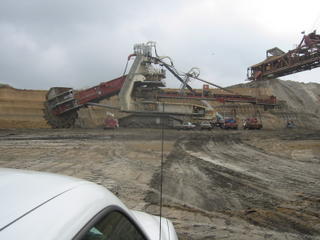Extreme machines II

Above is the Komatsu end-dump. It's typical haul capacity is about 290 tons and in case you are wondering, those guys are not from Gulliver's travel. The tire itself is about 3.2M high. Check out those 80in rims. Imagine running a flat, you need a huge-ass jack and a platoon of men to change it. In actual fact, these tires cost 10s of thousands of dollars and you just regroove them when they wear out.
Once you are up in the throne, you are probably 20 feet above ground. Line-of-sight forbids vision of a good 100 feet ahead of you. It is not uncommon to hear about end dumps running over pick-up trucks.
Why did the end dump cross the road...to take a dump. Don't tell me you didn't see that coming.


These two pictures are of a machine that is really one of a kind. It is called a cross-pit-spreader and it removes overburden to expose minerals. It does it at a remarkable rate; 20 million cubic yards of overburden per year. There are two major functions of this mobile machine. The bucket wheel strips the soil and the 250m long conveyor boom deposits it elsewhere. The machine is constructed in Austria.
During one of my covert missions to Puerto Rico, my fear was challenged while flying on a 6-seater twin propeller plane. It was like a roller coaster ride due to the impending storms in the Caribbean. Of course, as an adept agent I acted cool.
I flew past Arecibo. I almost forgot it was in Puerto Rico.
Arecibo is an astronomical observatory, which is one of the world's most powerful radar-radio telescopes, and the largest single-unit radio telescope in the world. This instrument, inaugurated in 1963, employs a 1,000-foot (300 meter) spherical reflector consisting of perforated aluminum panels that focus incoming radio waves on movable antenna structures positions about 500 feet (168 meter) above the reflector surface. The antenna can be moved in any direction, making it possible to track a celestial object in different regions of the sky. It collects radio astronomy, terrestrial aeronomy, and planetary radar data for scientists around the world. The telescope was featured in the movies GoldenEye (1995) and Contact (1997).
The National Astronomy and Ionosphere Center developed the observatory and it is operated by Cornell University under a cooperative agreement with the National Science Foundation. Conceived in 1958 by William E. Gordon, a Cornell professor of electrical engineering, the radio observatory has been operated, since its completion in 1963. The Arecibo Observatory owned by Cornell University, is powerful enough to receive signals transmitted by a comparable telescope located 1,000 light-years away.


Above are pictures of some of my work; contraption I built when I did time at the instituition under captivity before I managed to escape.
It is a time machine and the only one in the world. The flux capacitor resides in that Aluminum box you see. The PID feedback control system still requiree work as the phase difference between the Quantum wave generated by the flux capacitor and the Cosmic Neutrino background (CNB) caused inaccuracy of +/- 100 years. Mat love used it once but I was not sure if it was successful as he refused to talk about his traumatic experience and I did not bulge him further.
I still have ex-fellow inmates who are less fortunate than me. 100+ boy is one of them who was captured by babaric hoardes and currenly held captive in the Non-newtonion fluid mechanics lab. They abuse him with viscoelastic material up his cavities till he can perfect his machine that manufactures bread.


4 Comments:
aka 100+
I will escape to... one day
Give up, I know you are learning to enjoy the toture..
the time machine works! it works!
what a big ass spreader, dont u luv it when it spreads for u?..=) check ur boxers, it may be wet oredi..
Post a Comment
<< Home